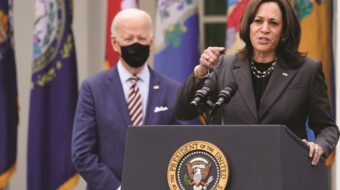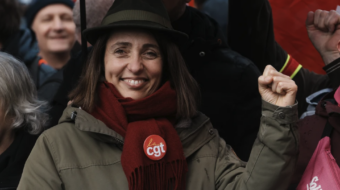Occupy Oakland’s National Day of Action, Nov. 2, 2011, is a day to be remembered for the lessons it offers us.
“Regular” folk poured out into the streets incensed at Wall Street and the local police, who had used excessive force two weeks earlier when an Iraq veteran received a head injury from a police projectile at an Occupy Oakland protest.
By midmorning, thousands spread out through downtown Oakland in several tributary marches, closing some of the city’s main thoroughfares.
We paused for a mini-rally by a Chase branch, as a richly colorful banner proclaiming “Make the Banks Pay!” was hoisted between two light poles across Webster Street.
That afternoon, we marched to the port in one gigantic mass.
Those of us arriving first watched in awe as wave after human wave poured in from the slope above the port complex, blocking all lanes leading to the docks.
As the sun was setting, a rich pinkish/orange hue engulfed the marching throng. It was a thing of indescribable beauty and power.
That evening, we went home in a triumphant mood.
We had won the battle for the hearts and minds of the 99 percent, without a single confrontation with police, a single injury or arrest. In fact, uniformed police were nowhere to be seen.
That night, a tiny grouping took it upon itself to take over an abandoned building.
Stories abound about the cops’ behavior and that of the small group resisting them. Who threw the first punch?
After the cops forcibly dislodged the protestors who resisted, a small group, reportedly with the Black Bloc, their faces masked, went on a rampage.
They set fires, vandalizing everything in sight, including a coffee shop by Occupy Oakland’s encampment whose owners had been supportive.
As dawn approached, a sizeable group of Oakland Occupiers could be seen busily cleaning up the mess the Black Bloc and their cohorts had left.
And so goes the tale of Occupy Oakland. A tiny minority makes a mess. A much larger group representing the sentiments of the overwhelming majority cleans it up.
Hiding behind the slogan, “diversity of tactics,” Black Bloc and a few others have argued that those who engage in acts of violence and vandalism have a right to do so.
In the name of unity, many folks who personally disapprove of violent tactics have been swayed to endorse “diversity of tactics.”
But a permissive attitude towards violent forms of activity defeats the very purpose around which Occupy Wall Street emerged: the fight of the 99 percent against the 1 percent.
It’s tragic enough that in the last confrontation with police some 400 protesters were arrested, I’m sure, many unwittingly believing they were being true to the cause.
It’s one thing to go to jail knowing that doing so will spur widespread and increasing support from masses of people. But it’s another to end up in jail for employing confrontational tactics for a dubious goal that brings diminishing results, and even disdain from many previous participants and supporters.
The strategic goal is to help unite the vast majority of the people in struggle against Wall Street and, in the process, divide, isolate and eventually wrest power from the main enemy – the banks and financial institutions of capitalism.
Tactics must correspond to what will win the fight and, by inference, win the overwhelming majority of the people.
Most Americans understand and accept mass action, including civil disobedience, so long as it’s nonviolent. As soon as the line is crossed support peels off rapidly.
Movements and organizations with long experience in struggle, as well as what we often describe as “average” Americans, embrace and promote Occupy Wall Street throughout the country because it has been speaking to what tens of millions know in their hearts and in their pocketbooks to be true.
Let’s not let fringe groups, like Black Bloc, or individuals whose motives are questionable, be allowed to hijack a great movement.
Our families, our relatives, our neighbors, our co-workers and their families – that is, the vast majority of Americans – in one way or another are being made to pay by Wall Street.
Massive joblessness, record evictions, increased poverty…
Cities, states and the federal government are being forced to cut social services and jobs to the bone when we need more of both.
By focusing almost exclusively on police violence and local government, those who remain in the lead of Occupy Oakland have lost sight of the forest for the trees.
It’s about Wall Street. It’s about marshalling the most diverse, massive constellation of class and social forces – including city governments and their residents – that will unite all the victims of Wall Street under the banner, “Make the banks pay!”
Oaklanders, we must exert our collective voice, as we did Nov. 2. “We ain’t gonna let nobody turn us around!” – not violence from the police or from a rump group.
“We’ve got our minds set on freedom,” freedom from Wall Street and the system that’s giving rise to it.












Comments